How to Clean a Toilet Brush & Holder
A clean toilet brush and holder are essential for maintaining a hygienic bathroom. Unfortunately, these items often get overlooked when it comes to regular cleaning. Over time, bacteria and germs can accumulate, making them breeding grounds for unpleasant odors and potential health hazards.
You can easily remove dirt and disinfect your toilet naturally with vinegar, baking soda, water, and a scrub brush. For a deep clean soak your brush and holder in a solution of bleach for at least 30 minutes then thoroughly rinse and air dry.
Read on for detailed instructions for the different cleaning methods including ideas for brushes with poop and stubborn stains. In addition, find valuable tips for storing, maintaining cleanliness, and preventing the buildup of dirt and grime.
Gathering the Necessary Supplies
Before embarking on your toilet brush and holder cleaning mission, gather the following essential supplies:
- Gloves and other protective gear: Protect your hands from harsh chemicals and bacteria by wearing disposable gloves.
- Bucket or container: A bucket or container will be used to soak the toilet brush in the cleaning solution.
- Cleaning solution: Choose a suitable cleaning solution, such as bleach, hydrogen peroxide, vinegar, or baking soda.
- Spray bottle for disinfectant application
- Scrub brush or sponge: A scrub brush or sponge will help you thoroughly clean the toilet brush and holder.
- Drying cloth/towel: A clean drying cloth is essential for removing excess moisture and preventing mold growth.
Spraying With Disinfectant to Sanitize your Brush after Use
This method is ideal if you want to kill germs and sanitize your immediately after use. While spraying is fast and convenient, it doesn’t remove tough stains and mineral deposits.
Steps
- Spray brush bristles, handle, and holder thoroughly with disinfectant cleaner. Allow to sit for the recommended contact time.
- For the holder, make sure to spray down the inside as well.
- Let the disinfectant sit,
- Scrub with brush
- Rinse clean and air-dry
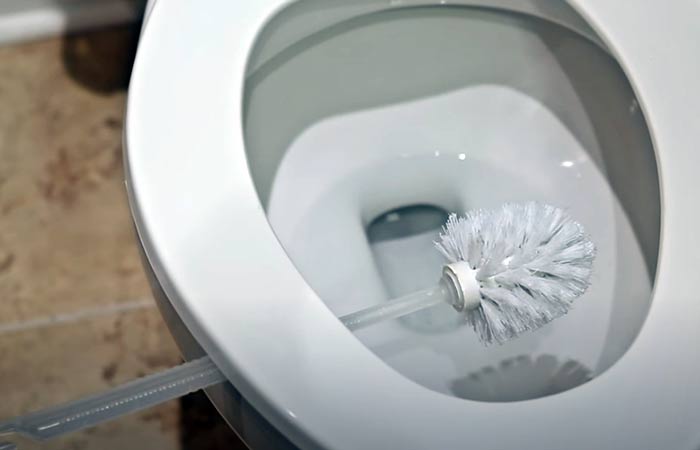
Cleaning your Brush Naturally without Bleach
There are several effective natural cleaning solutions you can use to disinfect and remove grime from your toilet brush and holder. Here are some of the most common methods:
Using Vinegar
Steps
- Fill the holder with equal parts warm water and vinegar. Soak the brush in this solution.
- The acidic vinegar dissolves mineral deposits and kills bacteria.
- Let soak for 30 minutes then scrub and rinse.
- Air dry
Vinegar is a natural disinfectant and deodorizer, making it a suitable choice for removing odors and light stains from your brush and holder. Acetic acid, the main ingredient in vinegar, helps to break down dirt and can reduce bacteria on dirty surfaces
While vinegar is natural and easily available, it can leave a slight odor that some people may not like.
Baking Soda
Steps
- Make a paste with water and baking soda.
- Scrub paste onto brush bristles.
- Rinse thoroughly afterward then air dry
Baking soda is a mild abrasive that can help remove stubborn dirt and grime without damaging the toilet brush or holder. However, it does not disinfect and the whole process can be messy.
Hot Water
Steps
- Fill the holder with very hot, even boiling water. Soak brush.
- Hot water will help loosen and dissolve buildup.
- Scrub afterward, then rinse and air dry
Hot water cuts through grime but you need to be careful to prevent burns
Combine Vinegar, Baking Soda, and Hot Water
You can combine the three natural methods above for better results
Steps
- Prepare the cleaning solution: Fill the bucket or container with enough hot water to submerge the toilet brush head. Add a generous amount of baking soda to the water and stir until it dissolves completely.
- Soak the toilet brush: Submerge the toilet brush head in the baking soda solution, ensuring the bristles are fully covered. Allow the brush to soak for at least 30 minutes or longer for more stubborn stains.
- Add vinegar: After the soaking period, pour a cup of vinegar into the baking soda solution. The mixture will start to fizz and bubble. This reaction helps to loosen dirt and grime from the brush.
- Scrub the toilet brush: Using a scrub brush or sponge, thoroughly scrub the toilet brush head, including the bristles and the base. Pay attention to areas where grime tends to accumulate.
- Rinse the toilet brush: Rinse the toilet brush thoroughly with hot water to remove any remaining baking soda solution and debris.
- Air dry completely before returning to the holder
Tip!
If you don’t have a bucket/container, you can your toilet bowl. This will also clean your bowl.
How Clean Toilet Brush with Bleach
Bleach is an inexpensive yet powerful disinfectant and stain remover. It effectively kills bacteria and germs while whitening your brush. However, it can be harsh on the toilet brush, holder, and toilet surfaces, so use it sparingly and dilute it with water.
- Fill a bucket with hot water, making sure it’s deep enough to submerge the brush fully.
- Add 1/2 cup of bleach to the water.
- Put on gloves and eye protection.
- Submerge the toilet brush fully in the bleach solution. Let soak for at least 1 hour.
- Remove the toilet brush from the solution and rinse thoroughly with hot water over a tub or sink.
- Rinse for at least 30 seconds.
- Air dry completely before returning to holder.
Cleaning with Hydrogen Peroxide
Hydrogen peroxide is a gentler alternative to bleach, offering mild disinfecting properties without the harshness. It’s particularly effective against mold and mildew.
- Mix hydrogen peroxide with hot water in the holder.
- Soak brush.
- It will bubble away grime. Let sit for 20 minutes then scrub and rinse.
- Air dry
While hydrogen peroxide deodorizes and whitens your brush holder with effervescent cleaning it may not sanitize as thoroughly as other methods.
Cleaning with Commercial Bowl Cleaners
You can also use a commercial toilet bowl cleaner to clean a toilet brush. In fact, some are often more effective than bleach or other DIY solutions because they are designed to specifically remove tough stains and odors from toilet bowls. You can also try out all-purpose commercial cleaners.
Here are some commercial toilet bowl cleaners that you can use to clean a toilet brush:
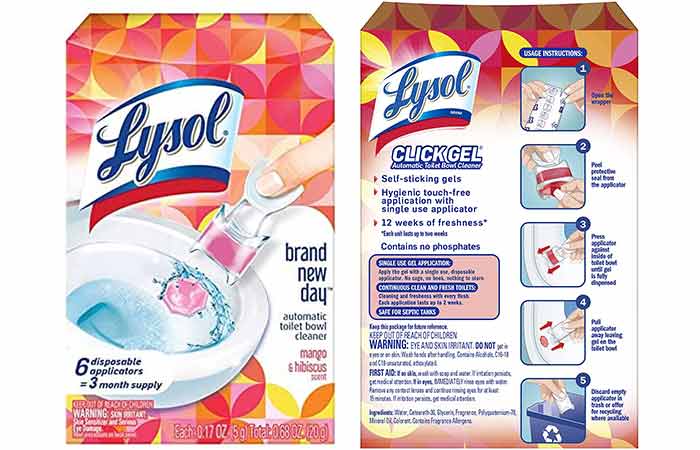
- Lysol Toilet Bowl Cleaner Gel: This gel-based cleaner clings to the bristles of the toilet brush and helps to remove stubborn dirt and grime.
- Clorox Toilet Bowl Cleaner: This liquid cleaner is effective at removing stains and odors, and it also has a disinfectant that kills bacteria.
- Scrubbing Bubbles Toilet Bowl Cleaner: This foaming cleaner is easy to apply and helps to remove tough stains and odors.
- Mr. Clean Toilet Bowl Cleaner: This all-purpose cleaner is effective at removing stains, odors, and mineral deposits.
- Zep Toilet Bowl Cleaner: This industrial-strength cleaner is tough on stains and odors, and it also has a disinfectant that kills bacteria.
To use a commercial cleaner to clean a toilet brush, follow these steps:
- Put on gloves.
- Pour a small amount of cleaner into a bucket or container.
- Submerge the toilet brush in the cleaner.
- Swish the brush around in the cleaner to dislodge any dirt and grime.
- Let the brush soak in the cleaner for 10-15 minutes.
- Scrub the brush with a sponge or brush to remove any remaining dirt and grime.
- Rinse the brush thoroughly with hot water.
- Let the brush air dry completely.
Here are some additional tips for cleaning a toilet brush with all-purpose or commercial toilet bowl cleaner:
- Experiment to see which solutions work best for your needs.
- If the brush is very dirty, you may need to soak it for longer than 10-15 minutes.
- You can also use a scrub brush to clean the toilet brush holder.
- Make sure to rinse the brush and holder thoroughly with hot water after cleaning.
- Do not use the toilet brush until it is completely dry.
- Choose a mild, non-abrasive all-purpose cleaner.
- Rinse and dry completely after cleaning.
How do I Clean a Toilet Brush with Poop on it?
Cleaning a toilet brush with poop on it can be a daunting task, but it’s important to do it regularly to prevent the spread of germs. Follow the steps below
- Put on gloves: This will protect your hands from germs and harsh chemicals.
- Open a window or turn on a fan to ventilate the area and reduce the smell of feces.
- Rinse the toilet brush: Hold the toilet brush over the toilet bowl and flush the toilet to rinse off any loose feces.
- Submerge the toilet brush in the cleaning solution: Fill the bucket with enough cleaning solution to submerge the toilet brush head. Allow the brush to soak for at least 30 minutes.
- Scrub the toilet brush: Using a scrub brush or sponge, scrub the toilet brush head thoroughly, including the bristles and the base. Pay attention to areas where feces tends to accumulate.
- Rinse the toilet brush: Rinse the toilet brush thoroughly with hot water to remove any remaining cleaning solution and debris.
- Dry the toilet brush: Allow the toilet brush to air dry completely before storing it in the holder.
How do you Clean a Badly Stained (Brown and Stubborn Stains) Toilet Brush?
Follow the steps below to remove stubborn and severe stains from your brush
- Soak the stained toilet brush in bleach solution or vinegar solution for 1-2 hours to remove stains.
- Use baking soda and scrub vigorously to lift brown stains from the brush bristles.
- Rinse thoroughly until the water runs clear.
- Repeat the process if needed for stubborn stains.
- Replace heavily stained brushes that don’t respond to cleaning.
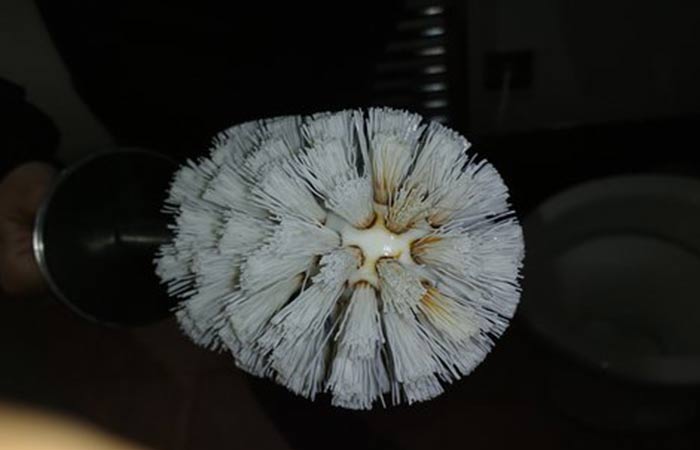
How to Clean a Toilet Brush Holder
To clean a toilet brush holder, you can use bleach, vinegar-baking soda-water solution, or any of the cleaners mentioned above
- Fill a bucket with water and add a capful or two of bleach
- Submerge the brush and holder in this solution for at least 10 minutes, allowing the bleach to disinfect and remove any stains.
- Use the scrub brush to manually scrub inside the holder, outside and the handle, removing buildup.
- Rinse thoroughly. Turn the holder upright and rinse all interior surfaces under running water until clear.
- Wipe exterior clean. Wipe down the outer surfaces of the holder with a clean wet rag.
- Allow the holder to completely air dry to prevent any bacterial growth or unpleasant odors from developing.
Tip: in place of bleach, you can use baking soda and vinegar, hydrogen peroxide or any of the commercial bowl cleaners mentioned above
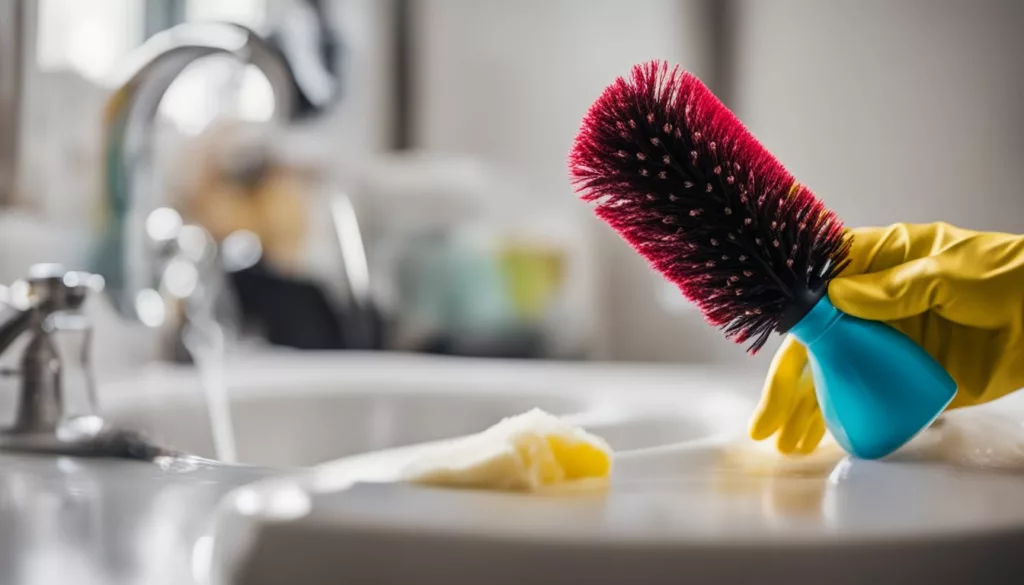
Proper Storage
Here are some tips to store your brush and holder properly
- Store the toilet brush in a well-ventilated area: This will help to prevent moisture buildup and the growth of mold or mildew.
- Avoid storing the toilet brush in a closed container: This can trap moisture and create an ideal environment for bacteria to thrive.
- Keep in a dry spot in the bathroom away from shower moisture
- Keep the toilet brush holder clean- Wipe down the holder regularly with a disinfectant wipe or solution to prevent the buildup of dirt and grime.
How Often Should You Clean Your Toilet Brush and Holder?
You should clean toilet brushes after each time they are used so that any germs that are picked up in the toilet do not sit in your bathroom, according to cleaning specialists.
However, the frequency of cleaning may vary depending on factors such as frequency of use, number of household members, and personal preferences/cleaning routine.
First, think about how frequently the toilet is used. If it’s in a high-traffic area such as a busy household or public restroom, more frequent cleaning may be necessary.
Second, take into account any visible stains or dirt on the brush bristles or holder. If they are noticeably dirty, it’s time for a cleaning.
Lastly, consider personal hygiene preferences and standards of cleanliness. Some people may prefer to clean their toilet brush and holder more often for peace of mind and optimal hygiene.
Some who a cleaning routine, for instance weekly, can clean their brush weekly.
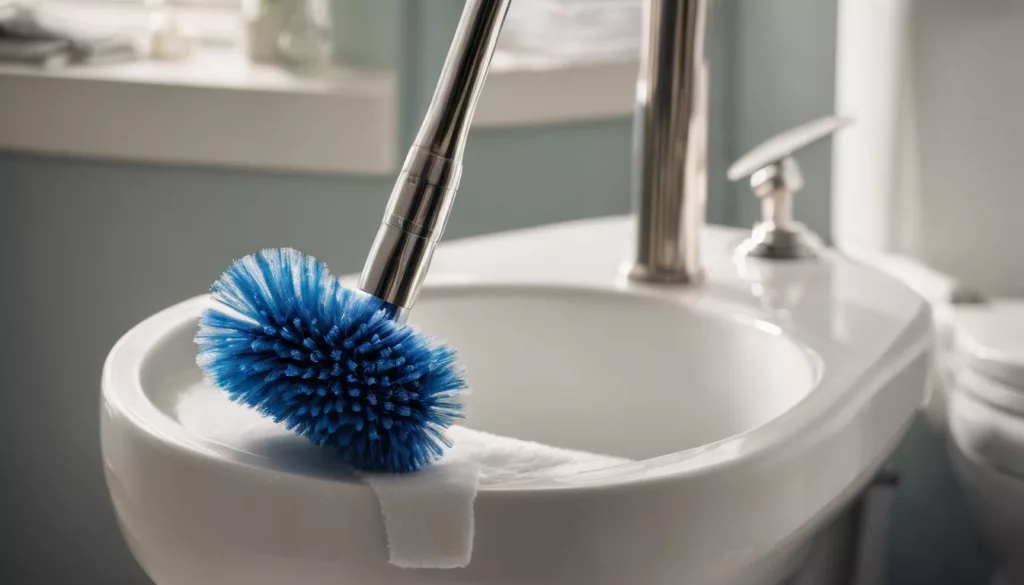
Tips to Keep Your Toilet Brush and Holder Clean
Following is a general guideline to keep your brush clean
After Each Use
- Rinse the brush thoroughly under running water. This prevents residue from hardening on.
- Spray holder with disinfecting solution. Let sit for 5 minutes before wiping dry with a rag.
Weekly Maintenance
- Check for grime buildup in holder cavities. Scrub spots with a brush and cleaning solution.
- Inspect for mold growth. Disinfect any problem areas.
- Clean bristles with mild soap and water.
Monthly Maintenance
Deep clean the brush and holder every few months by soaking the brush in a bleach-water mixture or any of the cleaning solutions mentioned earlier for at least 15 minutes. Make sure to rinse both the brush and holder thoroughly before allowing them to air dry completely.
Here’s why you need to keep your toilet brush and holder clean:
Prevent the Spread of Germs: Toilet brushes collect bacteria, and germs from the toilet with each use. Not disinfecting these can transmit pathogens around your bathroom and household.
Eliminate Stains and Odors: Residue, grime and mineral deposits can build up on the brush bristles and holder, leading to stains and foul odors. Regular cleaning prevents this.
Maintain a Hygienic Bathroom: Keeping your entire bathroom clean is important for you and your family’s health and comfort. The toilet brush and holder are part of this.
Make Cleaning More Effective: Starting with a dirty toilet brush just moves germs around instead of eliminating them. A clean brush cleans better.
Safety Precautions
- Wear gloves: Always wear gloves when cleaning the toilet brush and holder to protect your hands from harsh chemicals and potential exposure to bacteria and germs.
- Ventilate the area: Open windows or turn on fans to ensure proper ventilation while cleaning. This will help to dissipate any fumes from cleaning solutions and prevent you from inhaling harmful chemicals.
- Handle cleaning solutions with care: Read the instructions on cleaning solution labels carefully and follow them precisely. Avoid mixing different cleaning solutions, as this can create harmful fumes or reactions.
- Keep cleaning solutions out of reach of children and pets: Store cleaning solutions in a secure location away from children and pets to prevent accidental ingestion or contact.
- Rinse thoroughly: After cleaning the toilet brush and holder, rinse them thoroughly with hot water to remove any traces of the cleaning solution.
- Dry the toilet brush and holder completely: Allow the toilet brush and holder to air dry completely before storing them. This will help to prevent moisture buildup and the growth of mold or mildew.
- Dispose of cleaning solutions properly: Follow the instructions on the product label for safe disposal. Do not pour cleaning solutions down the drain, as they can contaminate waterways and harm aquatic life.
- Avoid using harsh chemicals: If possible, opt for milder cleaning solutions, such as vinegar or baking soda, to reduce exposure to harsh chemicals.
- Wash hands thoroughly: After cleaning the toilet brush and holder, wash your hands thoroughly with soap and water to remove any traces of dirt, germs, or cleaning solutions.
- Use a separate toilet brush for each bathroom: This will help to prevent the cross-contamination of germs and bacteria between bathrooms.
Remember, safety should always be your top priority when cleaning. By following these precautions, you can minimize the risks associated with cleaning a toilet brush and holder and maintain a healthy bathroom environment.
When Should I Replace My Toilet Brush?
A general recommendation is to replace a toilet brush every 3-6 months as it can harbor bacteria and become less effective at cleaning over time. If you use your toilet brush frequently or have multiple people in your household, you may need to replace it more often.
Other Pointer to replace your brush immediately
Replace sooner if damaged or worn: If the bristles are bent or frayed, the brush is losing its shape, or the handle is cracked or broken, it’s time to replace the brush.
Replace if it develops an unpleasant odor: Even if you clean your toilet brush regularly, it can still develop an odor over time. If your brush smells bad, it’s time to replace it.
When Should I Replace a Toilet Brush Holder?
Replace your holder every 6-12 months to avoid the buildup of bacteria and dirt. Immediately replace if it’s broken or cracked: it can no longer hold the brush securely and may need to be replaced. Replace sooner if it becomes discolored or stained
More on Toilet Cleaning